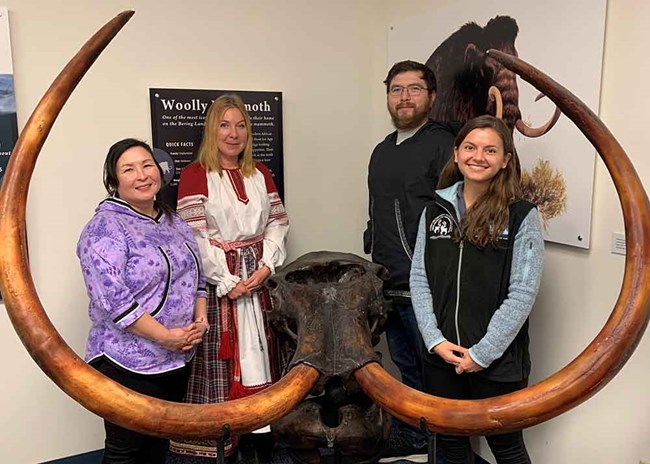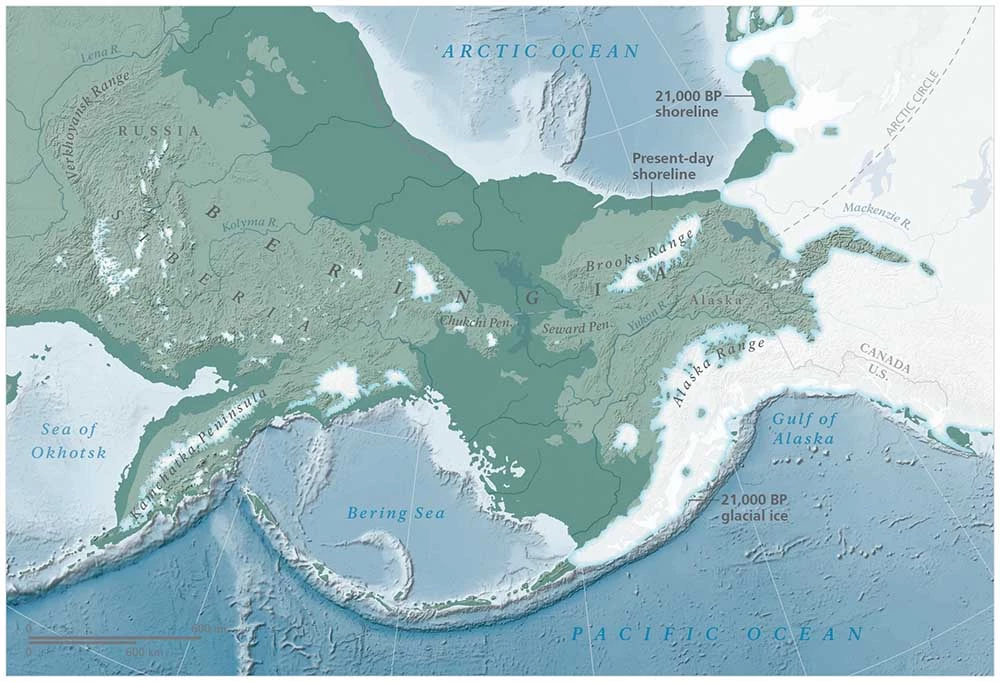Part of a series of articles titled Alaska Park Science - Volume 20, Issue 2. Beringia: A Shared Heritage.
Article
Beringia: A Region of Collaboration
Download a pdf of the full issue

Photo courtesy of Vic Knox
2021 is a very special year for the National Park Service (NPS) Shared Beringian Heritage Program. Thirty years ago, at the end of the Cold War, the warming in political relations between the U.S. and (at that time) Soviet Union inspired the leaders of these two countries to sign an agreement to foster cooperation in the field of environmental protection, cultural preservation, and the study of climate change in the Bering Strait region. Following this agreement, an annual appropriation from the U.S. Congress to the Alaska Region of the NPS established the Shared Beringian Heritage Program and provided funding for natural resource and cultural heritage projects that bridge the Straits. The program’s key goals are to promote conservation, sustainability, and increased knowledge of the region’s natural and cultural resources; to preserve subsistence opportunities; and to foster cultural connections and the exchange of traditional ecological knowledge in this diverse international area.
During the following three decades, the Shared Beringian Heritage Program has extended over $12M in funding to 172 U.S.-Russian collaborative projects, selected through an annual call for proposals. These collaborations, some of which are reflected in the articles presented in this volume, were accomplished in very dynamic physical and political environments. Each project pursued its own set of objectives, but also contributed to the overarching goal of bridging political differences and sustaining positive dialogue and interactions between the U.S. and Russia. Thirty years may not seem like a long time, but very few (if any) U.S.-Russian initiatives besides the two countries’ collaboration in space and the Shared Beringian Heritage Program can claim three decades of continuous, mutually beneficial, and productive work.

NPS/Michael Thompson
This achievement would not be possible without the commitment and expertise of the program’s staff, interns, volunteers and collaborators. Bob Gerhard, Peter Richter, Katerina Solovjova Wessels, Paul Haertel, Dale Taylor, Bill Welch, Jeanne Schaff, Bruce Greenwood, Janis Kozlowski, Elizabeth Shea, Rebecca Talbott, Vladimir Bychkov, Andrey Khalkachan, Andy Tremayne, Ian Buvit, Leigh Welling, Max Graham, and Peter Neitlich all contributed to the program’s work in the past. Presently, the Shared Beringian Heritage Program team includes superintendent of the Bering Land Bridge National Preserve Jeanette Koelsch, Russian language and outreach specialist Evguenia (Jenya) Anichtchenko, cultural anthropologist Nicole Braem, Scientist in the Park intern Megan Withers, and newly hired program manager Jacob Martin.
With 21 ongoing projects, the program is looking forward to the next decade of international dialogue and collaboration. On behalf of the Shared Beringian Heritage Program team, we would like to thank all who contributed to this volume and our projects, as well as our communities at large: local residents, culture bearers, scientists, environmental activists, artists, and educators on both sides of the Bering Strait. Happy anniversary, Shared Beringian Heritage Program, and many more to come!

Explore articles in this issue of Alaska Park Science
Qatŋut: Celebrating the Legacy of Trade, Dance, and Connection at Sisualik
Hannah Atkinson, Alisa Chen, Caelie Butler, and Justin Junge
Ocean Currents and Food Security: The Crucial Role of Bering Strait Traditional Knowledge
Julie Raymond-Yakoubian and Anastasia Yarzutkina
Nome Archaeology Camp: Using Place-based Education to Inspire the Next Generation of Stewards in the Bering Strait Region
Jillian Richie, Hannah Atkinson, Justin Junge, and Lisa Ellanna
Studying Long-term Patterns of Bering Strait Cultural Interaction and Exchange Through Archaeological Ceramic Analysis
Shelby Anderson, Irina Ponkratova, and Irina Zhushchikhovskaya
Frank Churchill’s 1905 Documentation of the Reindeer Service in Alaska
Amber Lincoln, Varpu Lotvonen, and Patrick Plattet
Moving the Needle: Enhancing the Conservation of Iconic Shorebird Species of the Beringia Region
Daniel Catlin
A Thousand Miles of Islands: Building Relationships Between Young People of the Commander and Pribilof Islands
Ann Harding, Natalia Fomina, Olga Belonovich, Anastasia Barsukova, Tonia Kushin, Ram Papish, Aquilina Lestenkof, Kendra Bush, Heather Renner, Karin Holser, and Priscilla Wohl
The Aleutians: Observing Recent Floristic Changes Along the Stepping Stones of the North Pacific
Eric G. DeChaine and Michael P. Williams
The Fur Seals of Early American Alaska
Amanda L. Shirnina
Beringia National Park: Preserving the Natural and Cultural Heritage of Eastern Chukotka
Vlada Valchenko
Alaska Park Science
Editorial Board
Grant Hilderbrand
Tahzay Jones
Jim Lawler
Jennifer Pederson Weinberger
Guest Editors
Evguenia Anichtchenko
Peter Neitlich
Managing Editor
Nina Chambers
Copy Editor
H. W. Murphy
Design
Nina Chambers
Alaska Park Science is the semi-annual science journal of the National Park Service Alaska Region. Each issue highlights research and scholarship important to the stewardship of Alaska’s parks.
Publication in Alaska Park Science does not signify that the contents reflect the views or policies of the National Park Service, nor does mention of trade names or commercial products constitute National Park Service endorsement or recommendation.
Last updated: December 15, 2021
